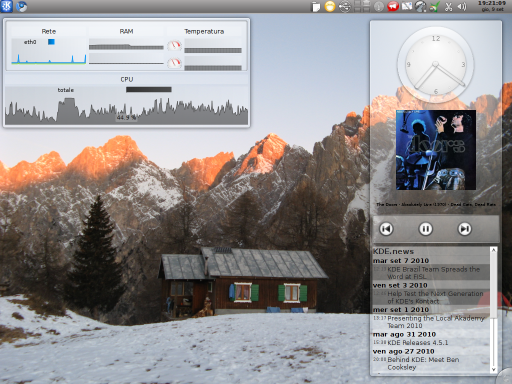Plasma/Desktop raggruppato
Desktop raggruppamento

Desktop raggruppamento è un tipo di attività per Plasma. Ti permette di raggruppare gli oggetti che hai posizionato sul tuo desktop in modi diversi.
Dopo averlo installato puoi selezionare Desktop raggruppamento come attività dalle impostazioni del desktop. Fai clic sulla casella degli strumenti del desktop e seleziona le . Qui seleziona la pagina e poi dal menu a discesa. Fai clic su e avrai un Desktop raggruppamento!
Altrimenti puoi aggiungere direttamente una nuova attività dal gestore delle attività selezionando e da qui .
Desktop griglia
Desktop griglia è un altro tipo di attività che fornisce una griglia per posizionare i tuoi oggetti e gruppi. Quando viene creata una nuova attività Desktop griglia, verrà creata una griglia con caselle di dimensione predefinita, tuttavia puoi sempre aggiungere e rimuovere righe e colonne per avere quante caselle puoi volere della dimensione che preferisci.
Puoi aggiungere un nuovo Desktop griglia allo stesso modo del Desktop raggruppamento.
Per vedere come gestire la griglia e il suo contenuto, guarda la sezione Gruppo griglia.
Pannello raggruppamento
Pannello raggruppamento è un pannello che supporta il raggruppamento dei tuoi oggetti.
Puoi aggiungere un Pannello raggruppamento facendo clic sulla casella degli strumenti del desktop e poi su . Quindi seleziona dall'elenco. Puoi poi spostare e configurare il nuovo pannello come fosse uno normale.
Gruppi
I gruppi sono elementi speciali che possono essere utilizzati per raggruppare insieme gli oggetti o altri gruppi. Ci sono parecchi tipi di gruppi, tutti con un modo differente di raggruppare gli oggetti. Le azioni di spostamento, rotazione o rimozione di un gruppo si rifletteranno sui suoi oggetti.
- Floating Group: Leaves the widgets you put inside it free to move as if they were on the default desktop.
- Grid Group: Puts its items in a grid.
- Stacking Group: Places its children one over the other, with every one of them moved a little to show the one under it.
- Tabbing Group: Creates one or more pages of widgets selectable by a tab bar. Every page puts its children inside a grid.
- Flow Group: Puts its items in a row or column.
Grid Group
When creating a Grid Group it will create by default a certain number of rows and columns.
If you want to add or remove a row move your cursor to the top or bottom edge of the group. If you want to manage your columns move it to the left or the right side. A thin strip will appear with two buttons: one that and one that a row or a column.
When you drop a widget in a Grid Group it will try to keep its size occupying as many cells as needed. You can anyway resize a widget already dropped: move the mouse cursor over the widget you want to resize and you'll see a little square appearing over a corner of the widget. Dragging it will result in the corner being dragged, with the opposite one staying still. All the corners can be dragged.
Adding a Group
To add a new group click with the right button of the mouse on a Grouping Desktop, on a Grid Desktop or on a Grouping Panel. Then select , which will cause a list of groups to appear. You can then add a group as you add a widget, dropping it over the desktop or panel.
You can add widgets in the new group moving an already created widget over it or dropping one from the widget selector. As you put a widget inside a group you can remove it simply by dragging it.
